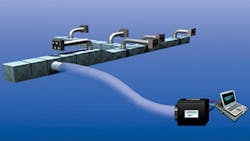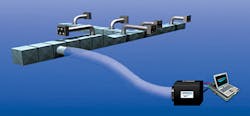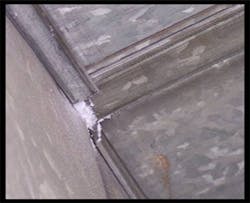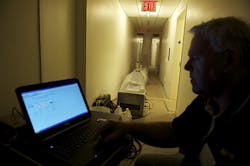With Aerosol-Based Duct Sealing, Hotel Gives Foul Odors the Shaft
Historically, fixing leaky ventilation shafts has tended to be a nonstarter for commercial-building owners. The expense and disruptive demolition typically involved in finding, accessing, and sealing leaks has made remediation measures impractical at best. As a result, most buildings in the United States are plagued by the poor indoor-air quality and high energy costs associated with improper ventilation. Now that a simple, non-intrusive solution in the form of aerosol-based duct sealing is available, property owners are addressing the problem head-on.
Case in Point
Although the JW Marriott hotel in Atlanta’s affluent Buckhead district always had been a model of elegance and luxury, owners of the 28-year-old building were struggling with issues related to a poorly designed ventilation system. Inadequate exhaust led to musty odors that had been plaguing the building for years. With long ventilation shafts embedded behind the building’s structure, accessing and repairing the problem had proven to be logistically and economically impossible.
A consultant brought in to evaluate the situation found exhaust levels differed substantially from floor to floor. Top floors received the full 40 cfm of exhaust they were designed to pull, while bottom floors received only 5 cfm or less. The consultant’s recommended solution: Start by cleaning and sealing each of the 10 23-story ventilation shafts running the length of the building.
After reviewing options, the hotel engineers opted for an innovative approach to duct sealing by which leaks are sealed from inside duct systems.
“We looked at several options, from traditional manual sealing to expensive sealing robots, and the aeroseal technology stood out as being by far the most sensible, economical, and non-intrusive process,” Frank Atkins, the hotel’s director of engineering, said.
Developed with funding from the U.S. Department of Energy, aeroseal duct sealing is administered as an aerosol mist of microscopic sealant particles that is blown into the interior of a duct system. Rather than coat the interior of the duct system, the sealant remains suspended in the air until it comes in contact with a leak. It clings to the edge of the leak and then to other sealant particles until the hole is filled.
With the method of sealing selected, a call to the experts at Aeroseal Southeast, a commercial duct-cleaning and sealing service provider headquartered in nearby Peachtree City, Ga., was made. A major selling point for hotel management was the sealing team’s guarantee it could do the work with minimal disruption to the building and to normal hotel operations. This was accomplished through careful coordination between the sealing team, the engineers, and hotel management. The best approach, it was decided, was to perform all sealing work on Mondays, the hotel’s quietest day of the week. Guests were booked into rooms away from the ventilation shafts being sealed on a given day.
Once prep work was completed, the sealing of each shaft took only about an hour. Using his own testing equipment, the hotel’s lead engineer confirmed what the computerized aeroseal system indicated: Average leakage was reduced from 397 cfm to 62 cfm, and during the entire process, few, if any, guests were even aware that such a significant remediation process was taking place.
In the end, sealing the ventilation leaks ensured all of the rooms on each floor of the hotel received proper exhaust. Musty odors that plagued the building for years are now gone. As a bonus, the facility manager expects the building’s energy bills to reflect thousands of dollars in savings annually, providing a return on investment of just three to four years.
“Aerosealing the ductwork proved to be a significant aide in improving the indoor-air quality and overall efficiency of the building,” Atkins said. “With no real viable solution to the problem, we’ve dealt with indoor-air-quality issues for some time now. This unique approach to duct sealing made the difference. It proved to be a key component to the overall strategy used to solve our ventilation issues.”
For Design Solutions author guidelines, call Scott Arnold, executive editor, at 216-931-9980, or write to him at [email protected].



